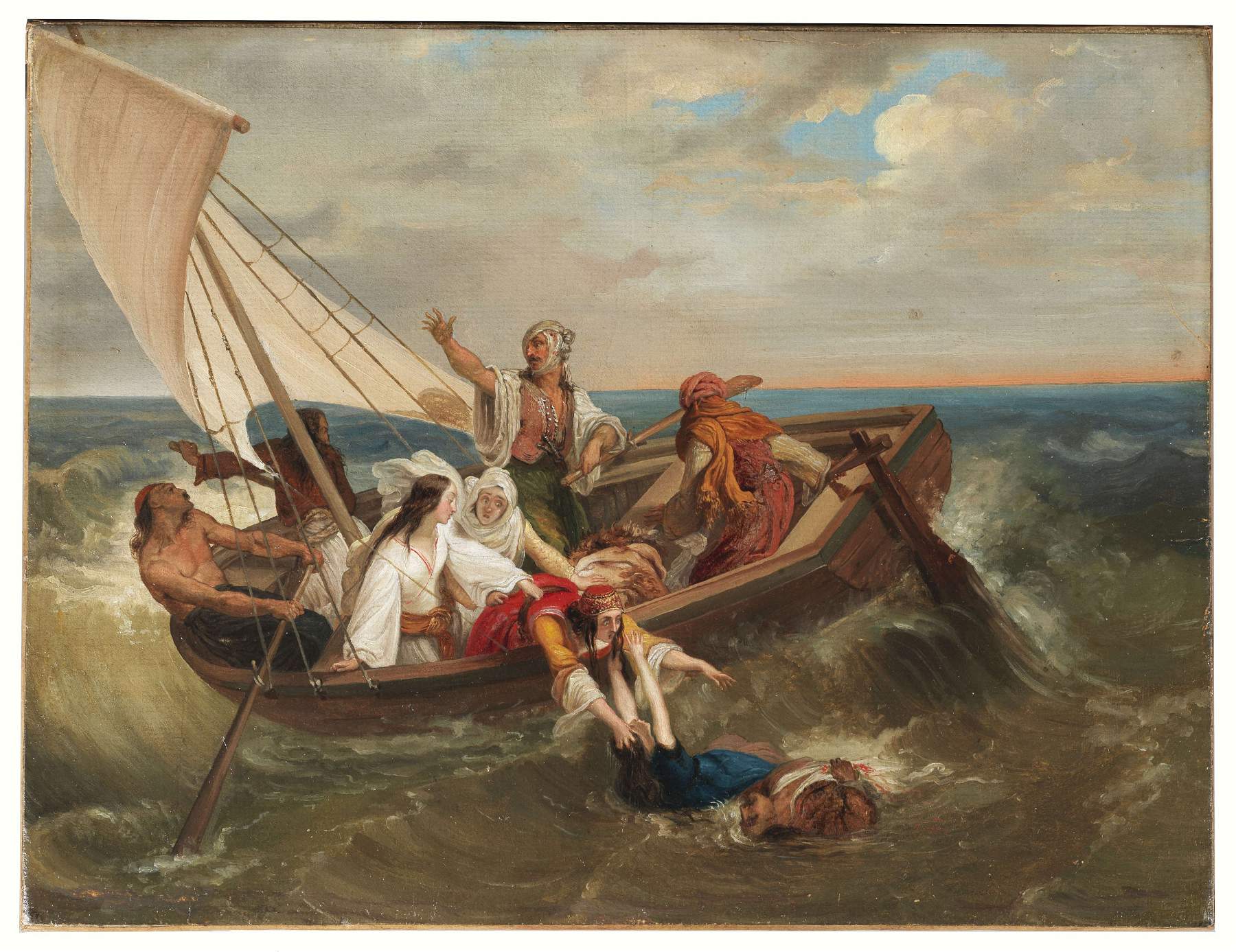Three important new acquisitions for thenineteenth-century collections arrive at the Uffizi . In fact, the Florence museum has secured two works by Francesco Hayez (Venice, 1791 - Milan, 1882), namely an Academic Nude in the Act of Drawing and the Boat with Greeks Fleeing the Massacre of Scio (an unpublished work, the latter, of extraordinary quality) and one by Giuseppe Bezzuoli (Florence, 1784 - 1855), the Portrait of Lorenzo Bartolini. The three works will replenish the itinerary of the Modern Gallery of Palazzo Pitti.
The two works by Hayez are an important addition to the museum’s collections, following the recent purchase of the Portrait of Count Arese in Prison (1828). Thus in just a few months the Uffizi has doubled (from three to six paintings) the number of works by the artist, considered to all intents and purposes one of the greatest painters of the Italian and European 19th century. The Academic Nude in the Act of Drawing, which bears the artist’s signature in the lower left corner, combines in a single figure the two constituent roles of the academic sitter, namely that of posing nude and that of drawing the human body. The work, executed by the artist during his Roman period (1809-1817), is juxtaposed with a manly study of 1812 that possibly depicts the same model.
Hayez’s painting of the Boat with Greeks Fleeing the Massacre of Scio , on the other hand, is inspired by a real event that actually happened: the mass slaughter by the Ottoman army of the Greek population of Parga on the island of Chios (formerly Scio) on April 12, 1822, and the subsequent escape by sea of the Greek survivors. At the time, the episode had aroused considerable emotional impact in Western Europe, giving rise to a pictorial and literary genre called “pro-Hellenism,” which celebrated the struggle of the Greek people against the Ottoman invaders. The theme was also particularly dear to Hayez, who produced a series of paintings of this subject (particularly famous is the one with the Parga Refugees , which is now preserved at the Pinacoteca Tosio Martinengo in Brescia), since through it he could express with great sentimental force the love of country that was to inspire the Italian Risorgimento. The Boat with Greeks Fleeing the Massacre of Shio instead was sent to Turin immediately after its purchase, where it will be on view in the exhibition Hayez and the Romantic Painter’s Workshop at the Galleria Civica d’Arte Moderna e Contemporanea until April 1, 2024. Instead, the Nude will immediately become part of the exhibition at the Gallery of Modern Art.


Bezzuoli’s portrait, which likewise will immediately enter the collection, was presented by the artist at the annual painting exhibition of the Royal Academy of Fine Arts in Florence (1825), and depicts one of the most celebrated sculptors of the Italian nineteenth century, Lorenzo Bartolini (Savignano, 1777 - Florence, 1850), a contemporary and friend of the painter, whose masterpieces the Gallery of Modern Art in the Pitti Palace possesses. Bartolini is depicted standing, in 16th-century clothing, observing the effect of a statue he is intent on sculpting; with one hand he holds his chisel while with the other he leans on a table on which his mallet is resting.
Bezzuoli and Bartolini’s acquaintance dated back to the years of their youth, when both were students of the neoclassical painter Jean-Baptiste Desmarais (Paris, 1756 - Carrara, 1813). Their bond had then strengthened over time, thanks to the understanding between the two in the way they conceived of art. The canvas, then, in addition to being a remarkable example of Giuseppe Bezzuoli’s portraiture, a genre in which the painter excelled, also offers valuable evidence of the human and intellectual bond between two of the greatest Italian artists of the time.

“These three acquisitions,” comments Uffizi Director Eike Schmidt, “further strengthen the section devoted to Italian Romanticism in the Modern Art Gallery of the Pitti Palace, which has been greatly increased in recent years. The portrait of Bartolini painted by Bezzuoli is like a visual commentary on the intellectual and artistic partnership between the two, which marks a fundamental chapter in the history of art in Italy. By Hayez, the study of the anatomical draughtsman, who in turn is nude and in a pose reminiscent of an ancient statue, reveals a self-mocking side of the painter. Finally, the painting depicting the Boat with Greeks fleeing from the massacre of Shio is a gem that embodies, yes, a vogue of the time, the pro-Hellenism that invested every field of culture, but it also fits into the theme dear to nineteenth-century painting, of survivors and refugees on the sea. This strand counts among its major examples Theodore Géricault’s The Raft of the Medusa (1818-19) and Ford Madox Brown’s The Last Look at England (1855). By combining the subject of Eugène Delacroix’s famous monumental canvas The Massacre of Shoo (1824) with the maritime theme of Géricault’s masterpiece, Hayez competes with the two most famous French history paintings of the period. At the same time, the atrocious surprise attack launched on the inhabitants of the island of Shiloh by the Ottoman army on Good Friday 1822, with theindiscriminate murder of tens of thousands of women, children, civilians, is unfortunately again of chilling and painful actuality, and makes us see, in every age, the cruelty of war, the inhumanity of every act of terrorism.”
 |
| The Uffizi acquires three important works including an unpublished work by Hayez |
Warning: the translation into English of the original Italian article was created using automatic tools. We undertake to review all articles, but we do not guarantee the total absence of inaccuracies in the translation due to the program. You can find the original by clicking on the ITA button. If you find any mistake,please contact us.